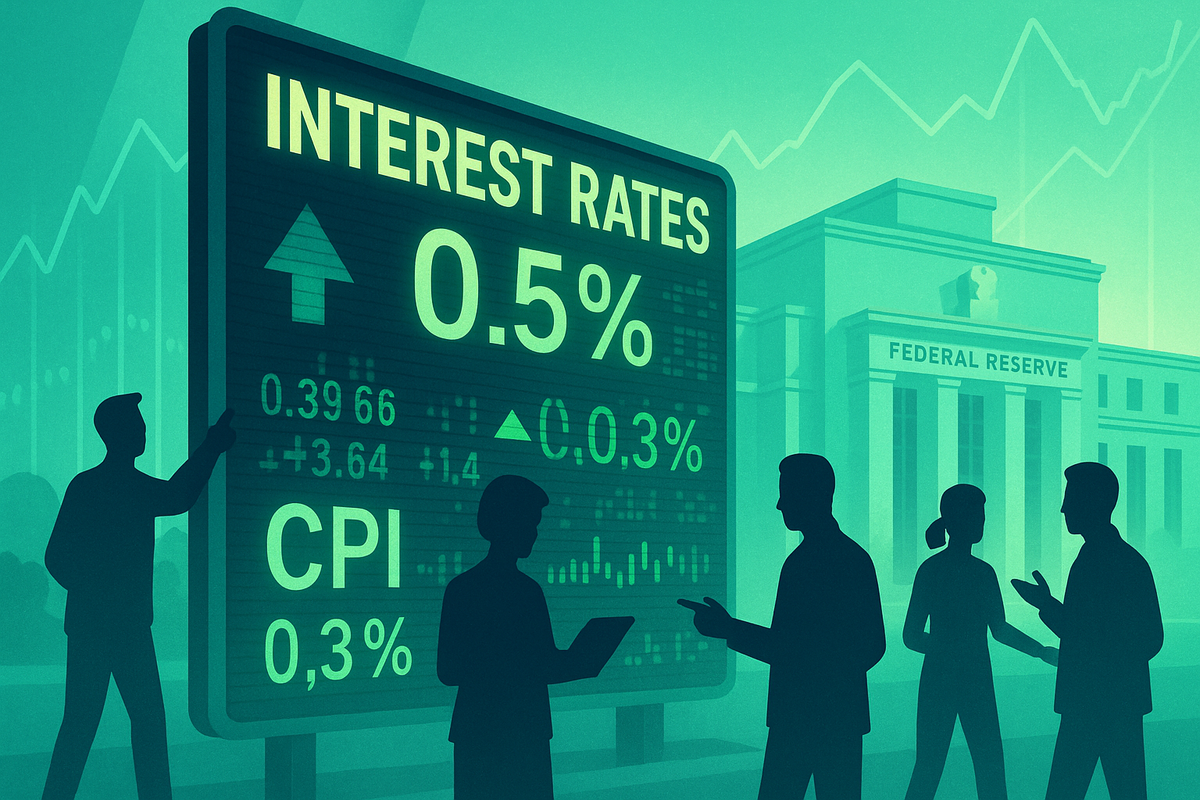
The financial markets are abuzz with renewed optimism for a September interest rate cut by the Federal Reserve, following the latest Consumer Price Index (CPI) report. This pivotal economic data has significantly shifted investor sentiment, with some traders now assigning a remarkable 94% probability to a rate reduction in the upcoming Federal Open Market Committee (FOMC) meeting. This heightened expectation signals a potential pivot in the Fed's monetary policy, moving away from its aggressive tightening cycle and towards a more accommodative stance, which could have profound implications for businesses, consumers, and the broader economy.
Inflation Cools, Markets Cheer: Is a September Fed Rate Cut Now Inevitable?
The recent CPI report served as a significant catalyst for the shift in market expectations. While the specific details of the report are crucial, the overarching narrative is one of cooling inflation, providing the Federal Reserve with greater flexibility to adjust its monetary policy. This development is a stark contrast to the persistent inflationary pressures that have dominated economic discussions for the past few years, prompting the Fed to embark on a series of aggressive rate hikes to tame rising prices. The timeline leading up to this moment has been characterized by a delicate balancing act for the Fed, aiming to bring inflation down to its 2% target without triggering a severe economic downturn. Key players involved include Federal Reserve Chairman Jerome Powell and the members of the FOMC, whose collective decisions dictate the nation's monetary policy. Initial market reactions have been overwhelmingly positive, with equity markets experiencing gains and bond yields declining, reflecting the anticipation of lower borrowing costs.
The CPI report, which measures the average change over time in the prices paid by urban consumers for a market basket of consumer goods and services, showed a deceleration in key inflationary metrics. This data point is a critical input for the Federal Reserve as it assesses the health of the economy and the effectiveness of its current policies. The Fed's dual mandate of maximizing employment and maintaining price stability means that a significant easing of inflationary pressures provides room to consider supporting economic growth through lower interest rates. The market's swift reaction, particularly the high probability assigned to a September cut, underscores the sensitivity of financial assets to even subtle shifts in economic data and central bank rhetoric.
Potential Winners and Losers in a Lower Rate Environment
A Federal Reserve interest rate cut in September could create a distinct set of winners and losers across various sectors of the economy and among public companies.
Potential Winners:
- Housing and Real Estate: A reduction in interest rates typically translates to lower mortgage rates, making homeownership more affordable and potentially stimulating demand in the housing market. Homebuilders like D.R. Horton (NYSE: DHI) and Lennar Corporation (NYSE: LEN) could see increased sales and profitability. Real estate investment trusts (REITs) could also experience a boost as borrowing costs for property acquisitions decrease.
- Technology and Growth Stocks: Growth-oriented companies, especially in the technology sector, often rely on future earnings potential, which is discounted at a higher rate when interest rates are high. Lower rates reduce this discount rate, making their future earnings more valuable and potentially leading to higher stock valuations. Companies like Microsoft (NASDAQ: MSFT), Apple (NASDAQ: AAPL), and other tech giants could see renewed investor interest.
- Consumer Discretionary: Lower borrowing costs for consumers could translate into increased spending on non-essential goods and services. Retailers, automotive companies, and leisure and hospitality businesses could experience a boost in demand. Companies such as Amazon (NASDAQ: AMZN) and Starbucks (NASDAQ: SBUX) might see improved consumer spending.
- Companies with High Debt: Businesses carrying substantial variable-rate debt would see their interest expenses decrease, directly improving their bottom line. This could be particularly beneficial for highly leveraged companies across various industries.
Potential Losers:
- Banks and Financial Institutions: While lower rates can stimulate lending activity, they can also compress net interest margins (NIMs) for banks, which is the difference between the interest income earned on loans and the interest paid on deposits. This could negatively impact the profitability of major banks like JPMorgan Chase (NYSE: JPM) and Bank of America (NYSE: BAC).
- Fixed Income Investors: Individuals and institutions heavily invested in fixed-income assets like bonds may see lower returns as new bonds are issued with lower yields. Existing bonds with higher yields may become more attractive, but the overall environment for fixed-income investing becomes less lucrative.
- Sectors Sensitive to Inflation: While a rate cut signals cooling inflation, if inflation were to unexpectedly re-accelerate after a cut, sectors that benefit from higher prices or have pricing power might face challenges. However, the current expectation is that inflation is under control.
The impact on these companies will depend on the magnitude and frequency of rate cuts, as well as their individual financial structures and market positions. Investors will be closely watching earnings reports and forward guidance from these companies for insights into how they are adapting to the evolving interest rate environment.
Industry Impact and Broader Implications
A potential September rate cut by the Federal Reserve would not merely be an isolated event; it would ripple through various industries and have broader implications for the global economy. This move would signify a significant shift in the Fed's strategy, acknowledging that inflationary pressures are sufficiently contained to allow for a more growth-supportive monetary policy. This fits into a broader trend of central banks globally navigating the post-pandemic economic landscape, balancing inflation control with the need to avoid recession.
The ripple effects on competitors and partners would be substantial. For instance, in the technology sector, lower borrowing costs could fuel increased investment in research and development, potentially accelerating innovation and intensifying competition. Smaller, growth-oriented tech companies might find it easier to secure funding, challenging the dominance of established players. In the financial sector, while banks might face compressed margins, the overall increase in economic activity driven by lower rates could lead to higher loan volumes and fee income, partially offsetting the margin pressure. Non-bank lenders and fintech companies could also see increased demand for their services as credit becomes more accessible.
From a regulatory and policy perspective, a rate cut could alleviate some of the pressure on fiscal policy. With monetary policy becoming more accommodative, there might be less immediate need for large-scale government spending programs to stimulate the economy. However, policymakers will still need to remain vigilant about potential asset bubbles forming if liquidity becomes too abundant. Historically, periods of sustained low interest rates have sometimes led to excessive risk-taking and inflated asset prices, a lesson the Fed will undoubtedly keep in mind. Comparisons to previous easing cycles, such as those following the 2008 financial crisis or during the early stages of the pandemic, will be drawn to assess the potential trajectory and challenges. However, each economic cycle has its unique characteristics, and the current environment, marked by supply chain recalibrations and geopolitical tensions, presents its own set of complexities.
What Comes Next
The immediate aftermath of a potential September rate cut will be closely scrutinized by market participants, policymakers, and the public alike. In the short term, we can anticipate continued volatility in financial markets as investors digest the implications of the Fed's decision. Equity markets may experience an initial surge, particularly in rate-sensitive sectors, while bond yields could continue their downward trend. The U.S. dollar might weaken against other major currencies as the interest rate differential narrows, potentially benefiting U.S. exporters.
Looking further ahead, the long-term possibilities are multifaceted. A sustained period of lower interest rates could foster a more robust economic expansion, encouraging businesses to invest and consumers to spend. This could lead to job creation and wage growth, contributing to overall prosperity. However, there are also potential challenges. If inflation proves to be more persistent than anticipated, the Fed might be forced to reverse course, leading to renewed market uncertainty. Furthermore, prolonged low rates could contribute to asset price inflation, creating risks of future financial instability.
Strategic pivots and adaptations will be required across various industries. Companies that have thrived in a high-interest-rate environment by focusing on cost-cutting and efficiency may need to shift their strategies towards growth and expansion. Businesses with significant capital expenditure plans might accelerate their projects, taking advantage of cheaper financing. Market opportunities could emerge in sectors that benefit from increased consumer spending and investment, such as technology, housing, and renewable energy. Conversely, challenges might arise for financial institutions that struggle to adapt to a lower-margin environment. Potential scenarios range from a "soft landing" where inflation is tamed without a recession, to a more challenging environment if economic growth falters despite lower rates.
Conclusion
The increasing odds of a September interest rate cut by the Federal Reserve, largely driven by the latest CPI report and robust investor optimism, mark a significant turning point in the current economic cycle. The key takeaway is that the Fed appears to be gaining confidence in its ability to manage inflation, opening the door for a more accommodative monetary policy. This potential pivot carries substantial implications for the market moving forward, signaling a shift from a period of aggressive tightening to one of potential easing.
The assessment of the market moving forward suggests a more favorable environment for economic growth, albeit with inherent risks. While lower borrowing costs can stimulate investment and consumption, the Fed will need to carefully navigate the path to ensure that inflation remains under control and that asset bubbles do not form. The lasting impact of this potential rate cut could be a more stable and predictable economic landscape, fostering long-term investment and innovation.
Investors should closely watch several key indicators in the coming months. Future CPI reports will be paramount in confirming the disinflationary trend. Additionally, labor market data, including unemployment rates and wage growth, will provide insights into the overall health of the economy. Finally, the Federal Reserve's communications, particularly speeches from Chairman Powell and the minutes from FOMC meetings, will offer crucial clues about the central bank's evolving outlook and future policy decisions. The coming months will be a critical period for understanding the full ramifications of the Fed's next move.





